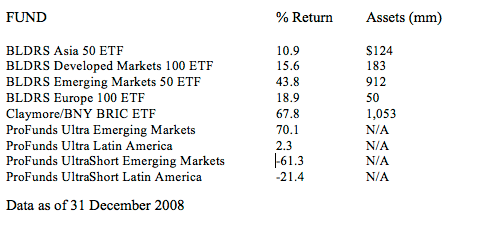DELISTING ADRS & A MORE INTRGUING OVER-THE-COUNTER MARKET
2 June 2008, Barron’s
What do British Airways, German pharmaceutical giant Bayer, and French water service leader Suez have in common? They’ve all left the New York Stock Exchange over the past year and now trade Over-the-Counter.
And they’re not alone.
Dozens of brand-name foreign firms, including Norwegian telecom Telenor, Swedish truck maker Volvo, and German chemical maker BASF, have taken advantage of a recent rule change by the SEC in June 2007 that’s enabling foreign publicly-listed companies to escape the expenses of a US listing.
“Compliance with Sarbanes Oxley has been an especially important trigger behind this exodus to the Over-the-Counter market,” explains Cromwell Coulson, CEO of Pink OTC Markets, the leading provider of pricing and financial information for OTC securities. Through the end of May, more than 70 foreign companies have delisted, with another 80 eligible to leave US exchanges, according to Coulson.
To get the SEC to stamp an exit visa, US trading in foreign firms’ shares must represent five percent or less of their global total volume over the trailing 12 months.
Before this change, the SEC had stuck to its Hotel California-like approach to foreign delisting, where checking out was very difficult. The purpose was to discourage foreign companies from selling shares and raising capital, providing US GAAP financials, then bolting, leaving domestic shareholders without a liquid market and standardized accounting.
But growing competition among the world’s capital markets is forcing the SEC to reconsider its strict policies. According to Anthony Moro, head of the Bank of New York Mellon’s Depositary Receipts business for the Americas, “new depositary receipt listings continues to trend towards non-US exchanges, particularly London and Luxembourg, which have less stringent regulatory requirements.” So the commission decided last year to ease its departure rules when it was evident that US investors wouldn’t be materially affected by delisting.
While this sounds like a procedural matter, the change is actually a big deal.
First, it acknowledges that New York is no longer the only table at the casino. With a growing number of efficient, liquid markets worldwide in which companies can raise capital coupled with the increasing regard for international accounting standards, many firms have decided that a US listing is no longer essential. And they have found that an OTC presence still retains the share currency necessary for negotiating a US buyout and to sustain share-compensation programs for employees working in the states.
Second, the shift in policy reveals that regulatory response to Enron et al is having an unintended backlash. “When I first read Sarbanes Oxley back in the summer of 2002,” recalls Ed Cofrancesco, president of the Florida-based International Assets Advisory that has $300 million under management, “I saw it as congressional overreaction to several large scandals that would send a slew of listed foreign companies scurrying from our markets.”
One of the early departures from the NYSE was UK-based Imperial Chemical Industries. Chief Financial Officer Alan J Brown explained that it “no longer made sense from a cost and administrative perspective to submit to the reporting obligations under the Exchange Act of 1934.” He expects delisting to save at least $8 million a year in exchange fees and compliance costs associated with Sarbanes Oxley.”
Until it was sold late last year to Akzo Nobel [a Dutch company that also recently delisted from the NYSE] for $15.8 billion, ICI had continued publishing its annual report, accounts, and other documents and communications accordance to SEC standards.
Third, delisting is changing the character of the OTC market. While some big foreign names like Swiss consumer-giant Nestle and Hong-Kong industrial conglomerate Hutchison Whampoa were always content with their OTC presence, many US investors still perceive this platform primarily as the place where sick companies go and fester after being bounced out of exchanges due to extremely low stock prices, lack of liquidity, or problems with financial reporting.
Now, OTC is home to some of the world’s great companies. But for US investors, relocation has cut liquidity and widened bid/ask spreads. It has directly affected funds and accounts that are required to hold only US-listed shares.
PowerShares, ProFunds, and Claymore offer a variety of international ETFs and mutual funds based on ADR indices. They are managed by the Bank of New York Mellon, comprised of shares with the largest market caps. According to Cheryl Workman, a bank vice president who overseas these indices, constituents can only be US exchange-traded ADRs.
Among the most significantly hit funds was the PowerShares BLDRS Europe 100 ADR Index fund, which has replaced 22 ADRs that delisted over the past year. This meant that BNY Mellon altered a substantial portion of the index’s character for reasons other than market performance. Sector weightings were thus changed as former shares were replaced not by comparable industry players but by companies with the next largest market capitalizations.
Daniel Peris, portfolio manager at Federated Investors, who directs more than $2.5 billion in separately managed accounts in the firm’s Strategic Value strategy, believes that delisting is reducing foreign opportunities for investment vehicles that are required to invest in listed shares. While he can sustain positions in ADRs that have delisted to the OTC, other SMAs may have to sell off such issues because they are only able to hold more liquid, US exchange-traded shares.
All this is not to intimate that foreign firms are bypassing the US. According to Anthony Moro, 39 new issues listed in the US in 2007, up from 34 the year before. Capital raised by new and existing issues doubled to $29 billion. But the majority of these offerings are emerging market companies, looking for capital and broad market acceptance.
Troublesome is that the larger, developed market companies are the ones heading out the door.



 GIR's Investing in the New Europe
GIR's Investing in the New Europe




